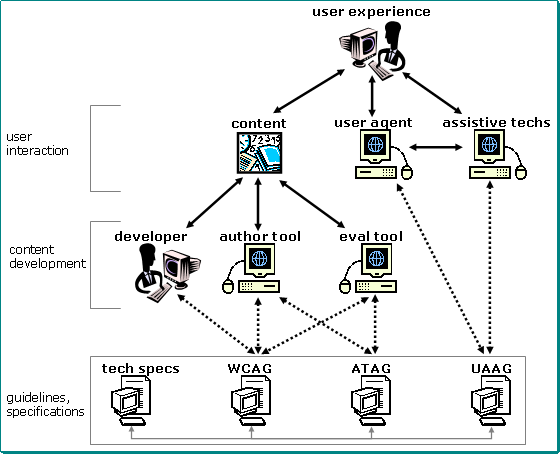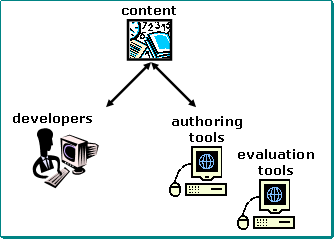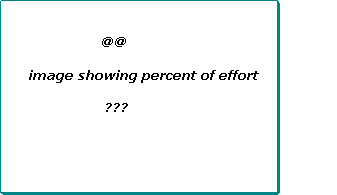Version: Early Concept Draft 2004.08.11
Note: This document is an unapproved draft and should not be
distributed, referenced, or quoted under any circumstances. This
document is under development by the Education and Outreach Working Group
(EOWG), and will be offered to other W3C groups and the public for review. A
change log lists revisions in
progress.
This document explains components of Web accessibility. Introduction to Web Accessibility provides additional information about Web Accessibility.

In order for the Web to be accessible, several components must work together, as explained below.

A person using a Web site ("user") brings their own knowledge, experiences, and in some cases adaptive strategies. For example, users have varying levels of knowledge of hoe to use computers and Web browsers, and have different experiences with different Web sites. Some people with disabilities use adaptive strategies, that is, they interact with Web sites in a particular way to meet their needs.

Whether or not a Web site is accessible to a user is largely based on:

The accessibility of the content is largely determined by:

WAI guidelines and W3C technical specifications (HTML, XML, CSS, SVG, SMIL, etc.) work together to inform accessible Web content and tool development.
There are significant inter-dependencies between the components; that is, each component relies on other components to form an effective system.
For example, for alternative text on images:

When any one component does not work effectively, it complicates the system and results in poorer accessibility. In some cases, the other components can compensate some; however, that usually involves much more effort and "work arounds" which are not good for accessibility in the big picture.
Currently the burden of developing accessible content is heavy on developers and thus requires a high level of developer knowledge, skill, and effort. Better authoring toolscould lower the burden on developers, and increase the accessibility of content.

One of the reasons that some accessibility features are not effectively implemented throughout the system is that there is little motivation for one component to implement a feature when it is not implemented well in the other components.
With authoring tool and user agent implementation:
If common user agents better supported a given accessibility feature, developers would be more inclined to want to implement it and demand that their authoring tool make it easy to implement.
Editor: Shawn Lawton Henry. This Web page is is under development by the EOWG.
Last updated $Date: 2004/08/12 20:40:14 $ by $Author: shawn $